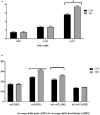Nourishing neonatal piglets with synthetic milk and Lactobacillus sp. at birth highly modifies the gut microbial communities at the post-weaning stage
- PMID: 36532479
- PMCID: PMC9748437
- DOI: 10.3389/fmicb.2022.1044256
Nourishing neonatal piglets with synthetic milk and Lactobacillus sp. at birth highly modifies the gut microbial communities at the post-weaning stage
Abstract
The importance of probiotics in pig production is widely recognized. However, the precise role of probiotics in regulating the gut microbiota of piglets has not been assessed extensively. Therefore, we intend to examine whether suckling pigs ingesting with synthetic milk (SM) and probiotics along with mother milk has a carryover effect on its growth and gut health at the post-weaning stage. A total of 40 [Duroc× (Yorkshire× Landrace)] neonates with an initial BW of 1.49 ± 0.28 kg were assigned to one of two treatments groups: control (CON) and treatment (TRT). Control group piglets were nourished with synthetic milk, while TRT group piglets were nourished SM with (1 × 109 CFU/g) Lactobacillus sp. probiotics. The treatment group piglets showed higher (p < 0.05) body weight and daily gain at week 3 than the CON group piglets. 16S metagenome sequencing showed average demultiplexed reads and denoised reads counts of 157,399 and 74,945, respectively. The total ASV taxonomy number classified with a confidence threshold > 70% (default) on sequence alignment with the SILVA v138 reference database was 4,474. During week 1, Escherichia-Shigella, Clostridium sensu stricto 1, and Bacteroides were confirmed as the major dominant bacterial genera in both the groups at the genus level. However, during week 2, the relative proportion of Escherichia-Shigella, Clostridium sensu stricto 1, and Proteobacteria was decreased, while that of Lactobacillus and Bacteroidota was increased in pigs receiving the probiotic supplement. During weeks 2 and 3, Firmicutes, Proteobacteria, and Bacteroidota phyla were dominant in both groups. During week 6, the relative proportion of Proteobacteria was slightly increased in both groups. Furthermore, Prevotella was confirmed as the major dominant bacterial genus in both groups during weeks 3 and 6. This study suggests that nourishing neonatal piglets with synthetic milk and Lactobacillus sp. probiotics from birth to 21 days would be beneficial to enhance the gut health of piglets and to overcome post-weaning mortality.
Keywords: growth performance; gut microbiome; piglets; probiotics; synthetic milk.
Copyright © 2022 Sampath, Song, Jeong, Mun, Han and Kim.
Conflict of interest statement
The authors declare that the research was conducted in the absence of any commercial or financial relationships that could be construed as a potential conflict of interest.
Figures




Similar articles
-
Dietary Bacillus spp. supplementation to both sow and progenies improved post-weaning growth rate, gut function, and reduce the pro-inflammatory cytokine production in weaners challenged with Escherichia coli K88.Anim Microbiome. 2024 Jan 24;6(1):3. doi: 10.1186/s42523-024-00290-y. Anim Microbiome. 2024. PMID: 38268054 Free PMC article.
-
An insight into the commercial piglet's microbial gut colonization: from birth towards weaning.Anim Microbiome. 2022 Dec 26;4(1):68. doi: 10.1186/s42523-022-00221-9. Anim Microbiome. 2022. PMID: 36572944 Free PMC article.
-
Potential effect of two Bacillus probiotic strains on performance and fecal microbiota of breeding sows and their piglets.J Anim Sci. 2022 Jun 1;100(6):skac163. doi: 10.1093/jas/skac163. J Anim Sci. 2022. PMID: 35512239 Free PMC article.
-
Effects of Lactobacillus salivarius isolated from feces of fast-growing pigs on intestinal microbiota and morphology of suckling piglets.Sci Rep. 2021 Mar 24;11(1):6757. doi: 10.1038/s41598-021-85630-7. Sci Rep. 2021. PMID: 33762614 Free PMC article.
-
Timely Control of Gastrointestinal Eubiosis: A Strategic Pillar of Pig Health.Microorganisms. 2021 Feb 3;9(2):313. doi: 10.3390/microorganisms9020313. Microorganisms. 2021. PMID: 33546450 Free PMC article. Review.
Cited by
-
Dietary eubiotics of microbial muramidase and glycan improve intestinal villi, ileum microbiota composition and production trait of broiler.J Anim Sci Biotechnol. 2024 Apr 10;15(1):59. doi: 10.1186/s40104-024-01010-x. J Anim Sci Biotechnol. 2024. PMID: 38594781 Free PMC article.
-
Dietary Bacillus spp. supplementation to both sow and progenies improved post-weaning growth rate, gut function, and reduce the pro-inflammatory cytokine production in weaners challenged with Escherichia coli K88.Anim Microbiome. 2024 Jan 24;6(1):3. doi: 10.1186/s42523-024-00290-y. Anim Microbiome. 2024. PMID: 38268054 Free PMC article.
-
Synbiotic-Glyconutrient Additive Reveals a Conducive Effect on Growth Performance, Fatty Acid Profile, Sensory Characteristics, and Texture Profile Analysis in Finishing Pig.Foods. 2023 Dec 28;13(1):105. doi: 10.3390/foods13010105. Foods. 2023. PMID: 38201133 Free PMC article.
References
-
- AI-Shawi S. G., Dang D. S., Yousif A. Y., Al-Younis Z. K., Najm T. A., Matarneh S. K. (2020). The potential use of probiotics to improve animal health, efficiency, and meat quality: a Review. Agriculture. 10, 452. 10.3390/agriculture10100452 - DOI
LinkOut - more resources
Full Text Sources

